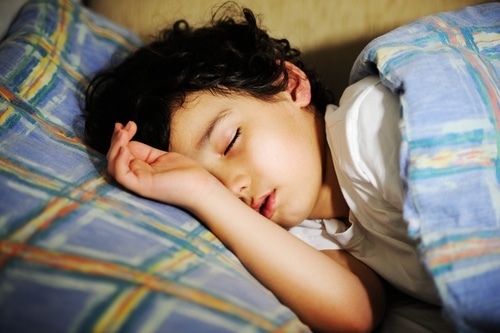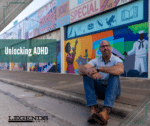
If your child or teen is struggling to stay awake, having trouble concentrating on homework, falling behind in school, is smaller than their peers, experiencing mood swings or still wetting the bed well beyond potty training, you may be at your wit’s end to find the cause — and the right treatment. You may be surprised to find out that the answer could be in how they sleep.
To be more specific, how they don’t sleep.
Children and Sleep Apnea
Sleep apnea is a disorder that may seem like a problem for only adults, but the condition can affect children and teenagers as well. However, sleep apnea is often overlooked in these age groups because its symptoms are not always obviously connected to interruptions in their sleep.
Some research studies from the National Sleep Foundation estimate that between 1.2 and 5.7 percent of children have obstructive sleep apnea, but many remain undiagnosed.
Research by the American Sleep Apnea Association has shown that obstructive sleep apnea symptoms usually emerge between the ages of 2 and 8.
If not treated, many children can suffer from lifelong side effects caused by the condition, including chronic illness.
The Signs of Pediatric Sleep Apnea and Pediatric Sleep Disorders
While some of the signs of obstructive sleep apnea in children are similar to those in adults, a few are common only in kids. Here are the most common symptoms of sleep apnea in children and teenagers:
- Frequent, loud snoring and noisy breathing
- Snorting, choking or gasping for breath while sleeping
- Periods of heavy breathing during sleep, known as hypopneas
- Very restless sleep (tossing and turning and difficulty staying asleep, unusual sleep patterns)
- Sleeping in strange positions (such as head arched far back)
- Nocturnal enuresis
- Daytime fatigue/difficulty staying awake
- Sleepwalking and waking up throughout the night
- Nightmares or night terrors (also called sleep terrors)
- Irritability and mood swings
- Learning problems
- Morning headaches
- Mouth breathing
- Chronic throat illnesses, such as strep throat, tonsilitis or adenoiditis
- Failure to thrive or undersized compared to peers
In addition to these effects, obstructive sleep apnea can increase your child’s risk of developing chronic and severe medical conditions, including obesity, diabetes, high blood pressure, stroke and cardiovascular problems.
How Sleep Matters
Are you noticing these symptoms in your child? If so, they may be living with obstructive sleep apnea (OSA), the sleep breathing disorder that causes interruptions in breathing during sleep. These interruptions are often caused by the soft tissues and muscles of the head and neck or the tongue falling back to block the airway when the body is relaxed at rest.
These interruptions can happen between a dozen to more than a hundred times each night, depending on the severity of your child’s OSA. In severe cases, breathing interruption can last more than one minute.
When breathing is interrupted during sleep, partial or full awakening can occur, which means a lack of restful sleep, even though your child may be ‘sleeping’ for eight hours or more each night.
When the body does not get enough restful sleep each night, effects such as chronic daytime fatigue, headaches, mood swings, anxiety, depression, nightmares and more can develop.
Beyond Sleep
Sleep apnea and other sleep breathing disorders have an impact that goes beyond just feeling tired. In children, sleep breathing disorders like obstructive sleep apnea have been shown to have connections to behavioral problems such as ADD/ADHD, irritability, anxiety, stress and angry outbursts.
Some studies have also found that children with sleep apnea or those who have regular interruptions in their sleep had a 40 to 100 percent higher chance of experiencing ADHD-like symptoms than children who breathe well at night and do not experience breathing interruptions.
The reason for this: Your child is tired. Even though they may be lying in bed for eight hours or more, they’re simply not getting adequate sleep.
It also means that they have lower blood oxygen levels, causing significant brain and behavior consequences.
Many children with obstructive sleep apnea experience difficulty sitting still and focusing and getting along with their peers, as well as mood swings, excitability and high anxiety levels.
As a result, many parents seek out behavioral therapies — and even medications — for their child, not knowing that their issues may be sleep-related.
What Causes Childhood Sleep Apnea?
The causes of childhood sleep apnea are often the same as those in adults. Things that put children at a higher risk of developing sleep apnea include:
- A narrow airway
- Poor muscle tone in the throat or mouth
- Large tonsils or adenoids
- Mouth breathing
- A large tongue
- Poor coordination of airway movements
- Frequent upper airway infections
- Sinus congestion
- Obesity
- Deviated septum and enlarged nasal turbinates, which contribute to narrow nasal passages
- Tumors in the upper airway or nasal passages
- Craniofacial abnormalities
- Genetic disorders, such as cerebral palsy
- Neuromuscular disorders
Interrupted growth of the midface can also contribute to the development of obstructive sleep apnea and an increased risk of obstructive sleep apnea. Interrupted facial growth can be caused by external and environmental factors and poor oral habits, including extended pacifier use and thumb-sucking.
When facial growth is interrupted, the upper airway cannot fully develop, which means more potential for airway obstruction and interruptions in breathing.
Interruption of lower jaw development can also contribute to breathing issues during sleep. For example, if the jaw is set too far back, the tongue is also positioned too far back and can fall to block the airway when the body is relaxed during sleep.
How Is Childhood Sleep Apnea Treated?
If you notice that your child is exhibiting the signs of obstructive sleep apnea, we recommend that you call our office to schedule a consultation. We will discuss the need for a sleep study to monitor your child’s breathing during sleep.
A sleep study will also reveal if and how often your child wakes up during the night and experiences hypopnea periods, and will help determine the severity of your child’s obstructive sleep apnea and the best treatment course.
Some options for treating your child’s sleep apnea include:
Avoiding allergens. If your child’s allergies are contributing to their sleep apnea because of chronic congestion, we recommend identifying and avoiding airway irritants and allergens, such as pet dander, pollen and tobacco smoke.
Losing weight. Weight is a significant risk factor in developing obstructive sleep apnea and can also make existing sleep apnea worse. If this is part of your child’s sleep apnea problem, talk to your pediatrician for more information to facilitate weight loss and improve sleep patterns.
Surgery. In some instances, airway obstruction is caused by enlarged tonsils or adenoids. Surgery to remove these glands may help improve the flow of air through the airway and improve breathing problems.
CPAP. The CPAP (continuous positive airway pressure) machine is a standard treatment for obstructive sleep apnea in children. This device works by sending air to force the airway open through a mask worn over the nose or nose and mouth. The CPAP treatment may be recommended for children with severe sleep apnea.
While the CPAP machine has long been the gold standard for treating sleep breathing problems in children and adults, many individuals find the devices claustrophobic, uncomfortable and loud. As a result, many skip using the machine to correct their sleep apnea.
Oral appliance. Oral appliance therapy, sometimes known as mandibular advancement therapy, is an effective and appropriate treatment that helps prevent airway obstruction (and breathing interruptions) by moving the lower jaw and tongue forward.
Oral appliance therapy is increasing in popularity for children because it is more comfortable and easier to use than the CPAP machine. The treatment works for children with all levels of sleep apnea.
Orthodontics. Not just any kind of orthodontics — facial growth orthodontics. This type of orthodontics, sometimes known as face-forward orthodontics or neuromuscular orthodontics, works to correct jaw development issues and midface growth and development problems.
Are you interested in learning more about how Legends Dental can help your child’s sleep apnea? Want to find out more about our treatment options? Call us today at 254-799-9540 to schedule a consultation.




